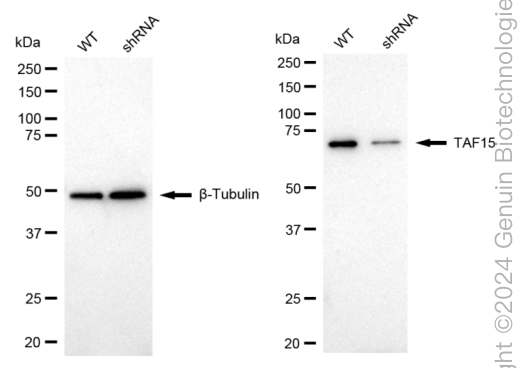KD-Validated Anti-TAF15 Rabbit Monoclonal Antibody
Rabbit monoclonal antibody
- SPECIFICATION
- CITATIONS
- PROTOCOLS
- BACKGROUND

Application
| WB, FC, ICC |
|---|---|
| Primary Accession | Q92804 |
| Reactivity | Rat, Human, Mouse |
| Clonality | Monoclonal |
| Isotype | Rabbit IgG |
| Clone Names | 24GB1830 |
| Calculated MW | Predicted, 62 kDa , observed , 62 kDa |
| Gene Name | TAF15 |
| Aliases | TAF15; TATA-Box Binding Protein Associated Factor 15; RBP56; TAF2N; Npl3; TATA Box Binding Protein (TBP)-Associated Factor, RNA Polymerase II, N, 68kD (RNA-Binding Protein 56); TAF15 RNA Polymerase II, TATA Box Binding Protein (TBP)-Associated Factor, 68kDa; TATA-Binding Protein-Associated Factor 2N; HTAFII68; TAFII68; TATA Box-Binding Protein-Associated Factor 2N (RNA-Binding Protein 56); 68 KDa TATA-Binding Protein-Associated Factor; TBP-Associated Factor 15; RNA-Binding Protein 56; RBP56/CSMF Fusion; TAF(II)68 |
| Immunogen | A synthesized peptide derived from human TAF15 |
| Gene ID | 8148 |
|---|---|
| Other Names | TATA-binding protein-associated factor 2N, 68 kDa TATA-binding protein-associated factor, TAF(II)68, TAFII68, RNA-binding protein 56, TAF15, RBP56, TAF2N |
| Name | TAF15 |
|---|---|
| Synonyms | RBP56, TAF2N |
| Function | RNA and ssDNA-binding protein that may play specific roles during transcription initiation at distinct promoters. Binds to ssRNA containing the consensus sequence 5'-AGGUAA-3' (PubMed:21256132). Can enter the preinitiation complex together with the RNA polymerase II (Pol II). |
| Cellular Location | Nucleus. Cytoplasm. Note=Shuttles from the nucleus to the cytoplasm |
| Tissue Location | Ubiquitous. Observed in all fetal and adult tissues |

Thousands of laboratories across the world have published research that depended on the performance of antibodies from Abcepta to advance their research. Check out links to articles that cite our products in major peer-reviewed journals, organized by research category.
info@abcepta.com, and receive a free "I Love Antibodies" mug.
Provided below are standard protocols that you may find useful for product applications.
If you have used an Abcepta product and would like to share how it has performed, please click on the "Submit Review" button and provide the requested information. Our staff will examine and post your review and contact you if needed.
If you have any additional inquiries please email technical services at tech@abcepta.com.














 Foundational characteristics of cancer include proliferation, angiogenesis, migration, evasion of apoptosis, and cellular immortality. Find key markers for these cellular processes and antibodies to detect them.
Foundational characteristics of cancer include proliferation, angiogenesis, migration, evasion of apoptosis, and cellular immortality. Find key markers for these cellular processes and antibodies to detect them. The SUMOplot™ Analysis Program predicts and scores sumoylation sites in your protein. SUMOylation is a post-translational modification involved in various cellular processes, such as nuclear-cytosolic transport, transcriptional regulation, apoptosis, protein stability, response to stress, and progression through the cell cycle.
The SUMOplot™ Analysis Program predicts and scores sumoylation sites in your protein. SUMOylation is a post-translational modification involved in various cellular processes, such as nuclear-cytosolic transport, transcriptional regulation, apoptosis, protein stability, response to stress, and progression through the cell cycle. The Autophagy Receptor Motif Plotter predicts and scores autophagy receptor binding sites in your protein. Identifying proteins connected to this pathway is critical to understanding the role of autophagy in physiological as well as pathological processes such as development, differentiation, neurodegenerative diseases, stress, infection, and cancer.
The Autophagy Receptor Motif Plotter predicts and scores autophagy receptor binding sites in your protein. Identifying proteins connected to this pathway is critical to understanding the role of autophagy in physiological as well as pathological processes such as development, differentiation, neurodegenerative diseases, stress, infection, and cancer.





